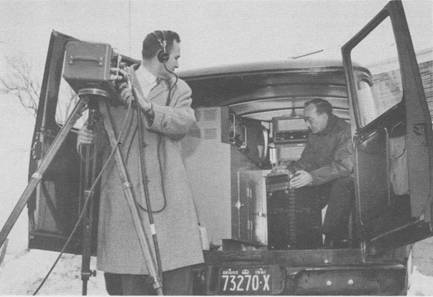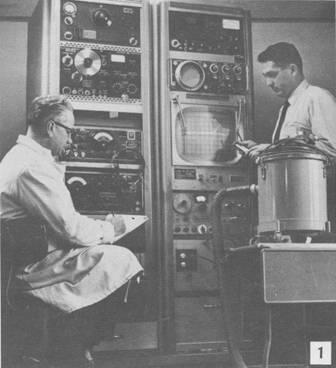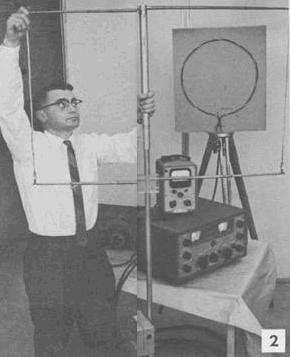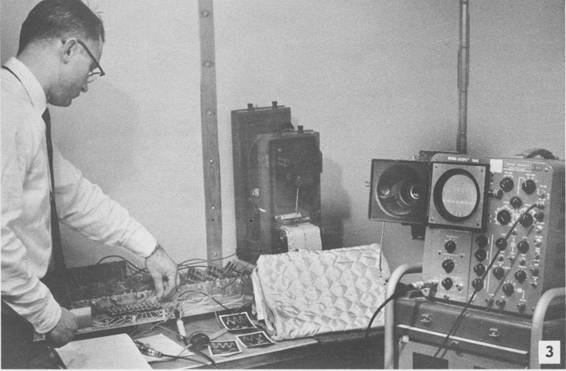
|
1961 All In A Day's Work by Yvonne McWilliam Information Services
"A tungsten bulb (some 35 years old), with a vertical zig zag filament, caused black bars and loss of synchronization in television reception. When the complainant was told what a little thing it was that caused all the trouble, he was so angry he threw the bulb on the floor and jumped on it."
This quote comes from the daily report sheet of a D.O.T. radio inspector. Such occurrences, though not frequent, are . . .
From St. John's to Victoria 29 "nerve centres" and a gross of radio inspectors relentlessly track down radio interference and many weird and wonderful things happen to these 144 men in the course of duty.
A telephone call, visit or letter from a complainant dispatches an interference car from the nearest radio interference office. An inspector may go to the home of John Citizen who has been missing his favourite T.V. program, to a manufacturer who is experiencing trouble with his testing equipment, to a retailer whose television receivers are bleating something only a Martian could decipher.
Cases like these - 25,188 last year to be exact - are all in a day's work. Almost every one resulted in the sources of interference being eliminated or suppressed.
To handle 25,188 cases the department's 75 interference cars, outfitted with the finest detection equipment, are always moving and listening, listening for noise. Big noises, small noises, any noise that causes interference. Even the smallest, near silent noise can cause interference - even a silent electric clock.
The Case of the Faulty Clock
Picture Toronto around City Hall. Heavy traffic, high buildings, everything to make interference detection difficult.
For a 3/4 mile radius around City Hall complaints were coming in of a constant steady bleat-20 to 40 buzzes per minute, 24 hours a day.
The job looked routine. The two inspectors who tackled it thought they would use the usual method of intensity. (In this method the modified communications receiver in the car locates the source of interference by registering greater intensity of noise as the car gets closer to the source.)
Nothing is left to chance - in fact, not even to the ear. The human ear is not very subtle. It is a poor judge of loudness, so a meter on the car's dashboard measures the intensity of noise precisely.
The Toronto case was a puzzler because - like in Perry Mason cases - there were too many clues. Maximum intensities were registered on both Queen and Richmond Streets. The inspectors decided to get two new views of the evidence by taking bearings from the ground level and from the roof of a three-storey building.
By drawing this new bead on the target interference, they hit it dead centre - on the 13th floor of a nearby 21-storey building.
Late at night they came back to the job, had the building's power shut off momentarily, and proceeded to track down the interference to a quiet office where a soundless electric clock had a fault in its rewind motor.
At one stage in their investigation, the inspectors had stood outside this very office, approximately 40 feet away, and were barely able to hear the interference, whereas on Queen Street, some 250 feet distant, the response had come in loud and clear.
This was one case solved by the bearing method; intensity readings had merely confused the inspectors.
On occasion complaints have even involved inspectors in neighbourhood feuds. A man calls in and reports that his estranged next-door neighbour (the one whose lawn mower he forgot to return last summer) is deliberately causing interference so he can't enjoy his favourite Wednesday night western. Usually, though, in such cases the trouble is coincidental and can be traced to a very real fault, since the average person (fortunately) isn't aware of the ways and means of causing deliberate interference.
There was one case, however, in a large Canadian city of a TV merchant hindering the sales of a rival by causing interference in his reception.
The Case of the Crooked TV Merchant
Two television sales and service establishments were located in the same block. Every time a prospective customer entered shop "A" the television reception there was affected so that the owner had difficulty demonstrating his new sets. He was convinced that his rival in shop "B" down the street kept watch and when anyone entered shop "A" deliberately caused interference.
Proprietor "A" reported his suspicions to the local radio interference office, but each time inspectors visited the rival's place of business everything appeared to be in order. The interference continued, but never when the inspectors were close at hand. It seemed that not only could this unscrupulous dealer spot customers at a distance, but radio inspectors, as well.
Department officials felt that, even though no irregularity had been witnessed by the inspectors, it was a highly suspicious situation. A letter was sent to owner "B" warning him of the seriousness of violating the Radio Act and pointing out "that any person so doing is guilty of an offence and liable to a fine not exceeding fifty dollars per day for each day during which such violation continues." Suddenly, the interference stopped!
The Beginning
As early as 1925 an interference service existed, but it was not until 1936 that legislation was passed to allow the government to prohibit or regulate the use of any machinery, apparatus or equipment, causing or liable to cause, interference to radio reception. The act was recently amended to control the sale of any apparatus likely to cause interference.
In enforcing this D.O.T. radio inspectors perform a very valuable service, not only to the general public, but to manufacturers, as well. If a product is chronically causing interference, they send detailed reports to headquarters at Ottawa. Engineers and radio technicians tackle the problem of determining how it can best be suppressed and, after a solution is worked out, the manufacturer is notified and told how to correct it-at his own expense, of course.
In the case of a householder, he, too, must assume the cost of any necessary work carried out on his possessions as the result of an inspector's recommendation. Of course, he has the choice of having the faulty equipment repaired or of taking it out of use. In instances where the article is of little value, say, an old electric warming pad, it is often more economical to scrap it than to have it modified according to requirements.
Technical Advice Appreciated
In practically all instances the radio interference section's recommendations are met with appreciation from manufacturers and individuals.
A particular brand of massage pad had been causing widespread interference in the areas where it was being used, so headquarters prepared a thorough report, detailing the required method of suppression, and wrote to the manufacturer, who in turn replied:
"Thank you for the information regarding the filtering of our equipment.
"The motor supplier has been changed and we believe that the one now in use is free from television or radio interference.
"We would like to add that all of our equipment, now in the field and causing interference, will be filtered and rectified at no charge to the customer if it is returned to our factory."
The section has pointed out to many manufacturers the need for reducing the interference capabilities of various sorts of electrical equipment and has advised and assisted in developing methods of reducing or eliminating the radio noise originating in a wide variety of appliances and apparatus.
Results are clearly evident in such fields as television. Five years ago complaints of sets causing interference numbered 500-600 per year. Today this figure has been reduced to a small fraction through manufacturers carrying out recommendations for suppression of interference causes. Models coming off the line now create little, if any, interference.
The inspectors and manufacturers are kept technically up-to-date through regular distribution of circulars outlining a wide variety of problems and methods of correcting them. The experts in the department are constantly on the job studying, investigating and developing methods and techniques of suppressing more completely, more economically and over more extended frequency ranges. As well, they are responsible for modifying and installing most of the equipment for the radio investigation cars, before they are sent out into the field to begin the never ending task of locating interference sources.
|
|
|
Links - Liens
|
|









